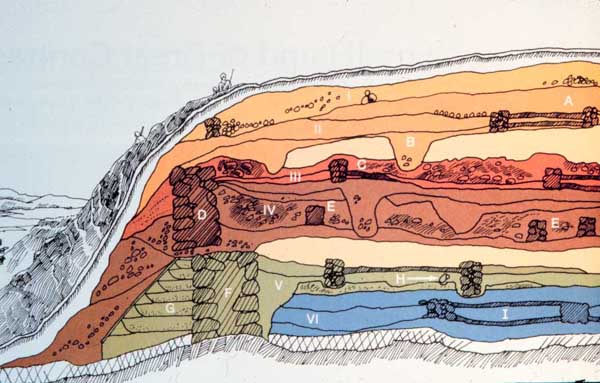Stratigraphy
Stratigraphy is the examination of the layering of archeological remains of a site. By generally adhering to the law of superposition, which establishes that layers of remains closer to the surface hail from a more recent period of history, stratigraphy can establish the relative dates of the different phases of remains, creating a sequential history of a site. However the chronology is often much more complicated than superposition alone, due to complex intertwined histories that are revealed in a cross section of soil. Archeological sites are often characterized by intertemporal relationships as spaces are used and reused by different civilizations throughout history. Through stratigraphy, the composition of the site can be seen in profile, establishing the varied histories layered in the soil.
Differences in soil color and texture can provide a fundamental delineation of individual layers, or strata. Additionally, the remnants of particular communities can be established by examining evidence written into the ground layers, such as land flattening, remains of dwellings, and midden deposits, the compilation of discarded implements of society as well as various garbage produced. Ground which has seen repeated human occupation over the span of thousands of years will reveal complex and intertwined histories, which can be difficult to unpack. Communities may reuse past constructions, soil layering may have been disturbed through tilling, and events such as flooding can disturb layers or deposit foreign soils. All this contributes to complicated historical context of strata, even after they are delineated.
The dating of specific strata is accomplished by application of more absolute dating methods to the remnants contained within. These include stylistic chronology, radiocarbon dating, dendrochronology, thermoluminescence dating, archaeomagnetism, and obsidian hydration. The compilation of the various dating methods enables the construction of a chronological history of a site’s stratigraphy.
The complexity of stratigraphical relationships can be seen in the image below. The different colors correspond to different occupations of a site, ordered chronologically from the latest (I) to the earliest (VI).
 Image Source: "Staten Island Museum at CSI: Archaeology Study Collection for Ancient and Medieval Civilizations". www.library.csi.cuny.edu/siias/webs.html, 2007.
Image Source: "Staten Island Museum at CSI: Archaeology Study Collection for Ancient and Medieval Civilizations". www.library.csi.cuny.edu/siias/webs.html, 2007.
Sources:
Biers, William R. “The Archaeology of Greece”. Cornell University Press, Itha
“Dating In Exposed and Surface Contexts”, ed.: Beck, Charlotte. University of New Mexico Press: Albuquerque, NM, 1994.
Michels, Joseph. “Dating Methods in Archaeology”. Seminar Press, New York: NY, 1973.
